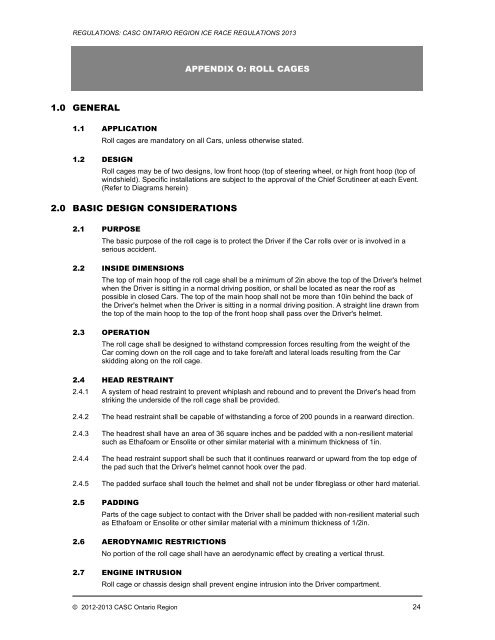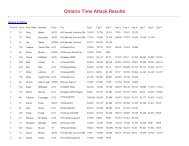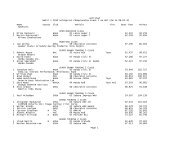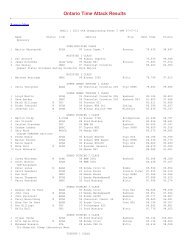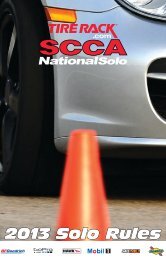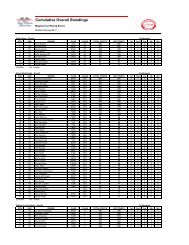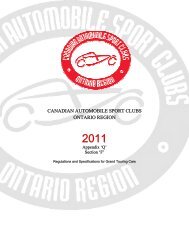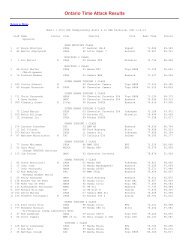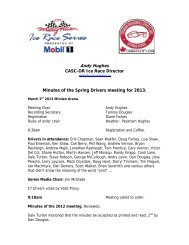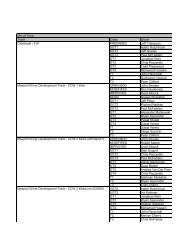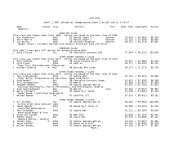2013 Rules and Regulations - CASC, Ontario Region
2013 Rules and Regulations - CASC, Ontario Region
2013 Rules and Regulations - CASC, Ontario Region
You also want an ePaper? Increase the reach of your titles
YUMPU automatically turns print PDFs into web optimized ePapers that Google loves.
REGULATIONS: <strong>CASC</strong> ONTARIO REGION ICE RACE REGULATIONS <strong>2013</strong><br />
APPENDIX O: ROLL CAGES<br />
1.0 GENERAL<br />
1.1 APPLICATION<br />
Roll cages are m<strong>and</strong>atory on all Cars, unless otherwise stated.<br />
1.2 DESIGN<br />
Roll cages may be of two designs, low front hoop (top of steering wheel, or high front hoop (top of<br />
windshield). Specific installations are subject to the approval of the Chief Scrutineer at each Event.<br />
(Refer to Diagrams herein)<br />
2.0 BASIC DESIGN CONSIDERATIONS<br />
2.1 PURPOSE<br />
The basic purpose of the roll cage is to protect the Driver if the Car rolls over or is involved in a<br />
serious accident.<br />
2.2 INSIDE DIMENSIONS<br />
The top of main hoop of the roll cage shall be a minimum of 2in above the top of the Driver's helmet<br />
when the Driver is sitting in a normal driving position, or shall be located as near the roof as<br />
possible in closed Cars. The top of the main hoop shall not be more than 10in behind the back of<br />
the Driver's helmet when the Driver is sitting in a normal driving position. A straight line drawn from<br />
the top of the main hoop to the top of the front hoop shall pass over the Driver's helmet.<br />
2.3 OPERATION<br />
The roll cage shall be designed to withst<strong>and</strong> compression forces resulting from the weight of the<br />
Car coming down on the roll cage <strong>and</strong> to take fore/aft <strong>and</strong> lateral loads resulting from the Car<br />
skidding along on the roll cage.<br />
2.4 HEAD RESTRAINT<br />
2.4.1 A system of head restraint to prevent whiplash <strong>and</strong> rebound <strong>and</strong> to prevent the Driver's head from<br />
striking the underside of the roll cage shall be provided.<br />
2.4.2 The head restraint shall be capable of withst<strong>and</strong>ing a force of 200 pounds in a rearward direction.<br />
2.4.3 The headrest shall have an area of 36 square inches <strong>and</strong> be padded with a non-resilient material<br />
such as Ethafoam or Ensolite or other similar material with a minimum thickness of 1in.<br />
2.4.4 The head restraint support shall be such that it continues rearward or upward from the top edge of<br />
the pad such that the Driver's helmet cannot hook over the pad.<br />
2.4.5 The padded surface shall touch the helmet <strong>and</strong> shall not be under fibreglass or other hard material.<br />
2.5 PADDING<br />
Parts of the cage subject to contact with the Driver shall be padded with non-resilient material such<br />
as Ethafoam or Ensolite or other similar material with a minimum thickness of 1/2in.<br />
2.6 AERODYNAMIC RESTRICTIONS<br />
No portion of the roll cage shall have an aerodynamic effect by creating a vertical thrust.<br />
2.7 ENGINE INTRUSION<br />
Roll cage or chassis design shall prevent engine intrusion into the Driver compartment.<br />
© 2012-<strong>2013</strong> <strong>CASC</strong> <strong>Ontario</strong> <strong>Region</strong> 24


